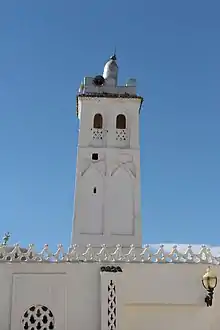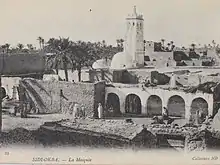Sidi Okba Mosque
Sidi Okba Mosque (Arabic: مسجد سيدي عقبة, Masjid Sīdī ʻUqbah) is a historic mosque in Algeria, located in the village of Sidi Okba, near Biskra. The mausoleum was first established as in 686 to house the remains of ʻUqbah ibn Nāfiʻ, a Companion of the Prophet and one of the prominent commanders of the Muslim conquest of the Maghreb, making it one of the oldest Muslim monuments in Algeria.[1] The mosque was built around the tomb and has been renovated many times over the centuries.[2][3]
| Sidi Okba Mosque | |
|---|---|
 Minaret of the mosque | |
| Religion | |
| Affiliation | Islam |
| Location | |
| Location | Sidi Okba, Algeria |
 Shown within Algeria | |
| Geographic coordinates | 34.7490277°N 5.8996375°E |
| Architecture | |
| Type | mosque |
| Date established | 686 (tomb) |
| Completed | c. 1025 and 1800 (renovations) |
Location
The mosque is located in the locality of Sidi Okba, 6 km south of the town of Tabuda and 10 km west of the city of Biskra, on the National road number 38 toward the locality of Khenguet Sidi Nadjil.[4][3]
History

ʻUqbah ibn Nāfiʻ, on his return from the victorious Battle of Vescera in the Atlas Mountains, was killed by the army of the Berber Christian king Kusayla ibn Lamzah in an ambush outside the town of Thouda in 683.[5]
He was buried in the current village of Sidi Okba, and later the mosque was built on top of it for commemoration. It is not exactly recorded who built the mosque. Some consider that it was the followers of Uqba who were captured during the battle, and later redeemed by the judges in Tunis from the prison. Commander Zuhayr ibn Qays sent them back along with other Muslims to Thouda, where they built the mosque.[4]
The building was not constructed all at once[2] and was likely remodeled and expanded several times.[1] The tomb, the oldest part, probably dates to 686,[3] making it one of the first known Muslim monuments in Algeria.[1] The decorated cedar-wood doors of the tomb have been dated by Georges Marçais the first half of the 11th century (circa 1025) during the Zirid period, based on a stylistic comparison with Zirid woodwork in the Great Mosque of Kairouan and with contemporary inscriptions on stelae found in Tunisia.[6][3] This likely indicates a major renovation at this time.[3]
A zawiya was added to the mosque in 1665.[2] Other inscriptions found in the mosque likely indicate the dates of further repairs or expansions.[3] One inscription dates the mosque's mihrab to 1214 AH (1799 AD) and another inscription on a wooden plaque gives the year 1215 AH (1800 AD).[3][2] These inscriptions also name Muhammad ibn 'Umar al-Tunisi as the sponsor of the work.[2]
Architecture

The mosque is irregularly shaped with 60 meters length and 37 meters width. It consists of three hallways and the main door at the south.[4] The building is designed in very simple hypostyle manner, similar to the earliest mosque built by Muhammad in Medina. The mostly flat roof of the prayer hall is supported by undecorated horseshoe arches held up by whitewashed columns, some of which are made of palm tree trunks.[3][2] There are two domes: one above the mausoleum and the other in front of the mihrab.[3] The mihrab is covered by a semi-dome and is decorated with stucco carved in simple and irregular interlace patterns, including engaged columns with capitals carved with grooves and stylized palm-tree motifs.[3][1] The mausoleum occupies the southwest corner of the mosque.[2]
References
- Benouis, Farida; Chérid, Houria; Drias, Lakhdar; Semar, Amine (2022). "I.1.a Sidi Okba". An Architecture of Light: Islamic Art in Algeria. Translated by Harter, Judy. Museum With No Frontiers. ISBN 9783902782229.
- "Mausoleum and Mosque of Sayyidī (Sidi) 'Uqba". Qantara-med. Archived from the original on 2022-01-11. Retrieved 2022-01-11.
- Lafer, Ali. "Sidi 'Uqba (mosque, minaret and tomb)". Discover Islamic Art, Museum With No Frontiers. Retrieved 2023-08-08.
- مساجد لها تاريخ.. مسجد عقبة بن نافع بــبــسكرة في الجزائر. Al-Bilad. Retrieved January 9, 2018.
- Conant, Jonathan (2012). Staying Roman: Conquest and Identity in Africa and the Mediterranean, 439-700. Cambridge University Press. p. 280. ISBN 978-0-521-19697-0.
- Bourouiba, Rachid (1973). L'art religieux musulman en Algérie (in French). Algiers: S.N.E.D. p. 26.
Further reading
- Marçais, Georges (1957). "Le tombeau de Sidi-Oqba". Mélanges d’histoire et d’archéologie de l’occident musulman (in French). pp. 151–159.
External links
- Images of Sidi Okba Mosque in Manar al-Athar digital heritage archive